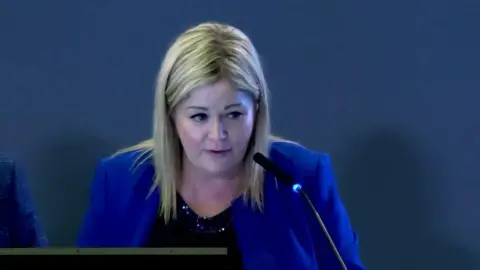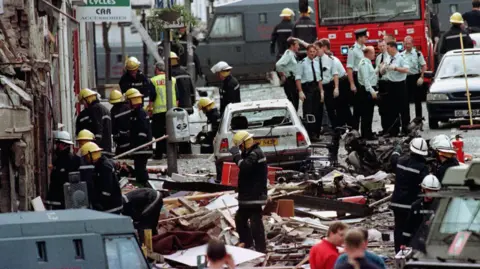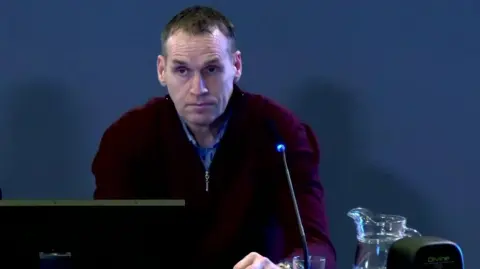Bomb survivor recalls being trapped under engine while on fire
 omagh bombing inquiry
omagh bombing inquiryA woman who lost a leg and was badly burnt in the Omagh bombing has described the moment the engine of the car that exploded landed on top of her and trapped her underneath.
Pauline Harte was 19 and had been working at a shop in the County Tyrone town when the Real IRA bomb that killed 29 people, including a woman pregnant with twins, went off.
She told the inquiry how the engine of the car used for the bomb landed on her legs, with the axle, which was on fire, resting on her waist.
"I was on fire underneath it," she said.
Warning: This page contains distressing details
'The tar was melted around me'
"I didn't know it was a fire, because fire has the colour yellow in it. I saw deep black, orange and red colours moving and it sounded as angry as it looked," Ms Harte told the inquiry.
She said her ears hurt, and everything was muddled as people screamed above the noise of the engine.
"I knew I was trapped, and reached my hand down to see what was stopping me. I touched the bar across my stomach, and that is my first memory of the pain. The tar was melted around me, and my elbow was sunk into it," she said.
She praised the "dedication and selfless actions" of the police officers and members of the public who helped free her.
The men burnt their own hands in the process, but they did not stop to tend to their injuries.
"They kept on helping other people until there was no-one left to help," Ms Harte said.
"One of the men told me later that he went home with my skin melted into his hands."
'Agonising searing pain'
 PA Media
PA MediaMs Harte's injuries included broken ribs, a broken collarbone, a punctured lung and third-degree burns from the waist down.
She was later transferred to the burns unit in the Royal Victoria Hospital in Belfast.
"Being burnt is horrific. I have many memories of screaming in pain, and my voice has never been the same," she said.
"I remember the pain of the burns being so acute that I could feel the vibrations from someone walking in heels, it travelled up through my body until I could feel it in my teeth.
"It was an agonising, searing pain, and when I closed my eyes everything was white."
Ms Harte had two amputations and said she could describe the horror of the word "amputation".
She said she "couldn't and wouldn't accept that it was going to be a reality" and was frightened to know it would be permanent, "that I couldn't change it".
"I remember begging for any other solution, it just felt like such a horrifying situation and I felt so desperate for it not to be me."
Ms Harte said, more than 26 years on, she was still in "awe of what was done" for her by "so many people".
"They are the reason I exist and walk tall," she said.
"I see us growing through the different ages that those who lost their lives in the bomb were at.
"My body is broken but I will be forever thankful that I don't have a broken heart."
'Shrapnel still in my body'
The inquiry also heard from a woman who was working as a traffic warden and was injured in the explosion.
Rosemary Ingram was helping to direct traffic before the car bomb detonated.
In a statement, read by a lawyer, Ms Ingram described how she felt a "thud" in her back and thought she had been hit by a car.
She said shrapnel was embedded in her legs, buttocks, neck and shoulder, and she underwent multiple surgeries to have it removed.
"Larger fragments were surgically removed but I still have deep small fragments in my body that the consultant surgeon considered too dangerous to remove," she said.
"Twenty-six years after the explosion, I still have shrapnel coming out of my body, sometimes with ongoing bleeding."
Ms Ingram, who lost her sister-in-law Ann McCombe in the blast, said she lived with trauma.
"We had to leave our home in Omagh because it was too close to the hospital and each time I heard the sirens, I had flashbacks and experienced PTSD," she said.
Ms Ingram detailed a "humiliating" experience of being strip-searched in 2002 when she was seeking compensation for her injuries at the High Court.
She said lawyers wanted to see the scars on her body and carried out the search in a small room.
"I was told to strip to my underwear and to stand in the corner of the room facing the wall in front of the panel of lawyers so that the Northern Ireland Office compensation agency could examine my scars to assess how much money I should be given," she said.
"One of the lawyers even pulled with his pen at my underwear to see the extent of the scars. The experience made me feel like a victim all over again."
She condemned the "imbalance" in a system in which she said victims of terrorism were "forgotten" and the perpetrators continued "to make their voices heard".
'Never got the opportunity to say goodbye'
Earlier, the inquiry heard how a woman was so badly injured by the bomb that she could not attend the funeral of her sister who was killed in the attack.
Nicola Marlow sustained life-changing injuries in the blast.
She told the inquiry she was forced to undergo "multiple gruelling surgeries and therapies to try to survive and recover".
In Ms Marlow's statement, read to the inquiry by the family's lawyer, she described how she and her sister were planning to meet in town.
"Had I not been there at that time, she wouldn't have been either," she said.
"This is a burden that I have carried for years."
She said the events of that day changed her and her family's world forever.
"Due to my injuries being so bad, I was unable to attend my sister's funeral meaning I never got the opportunity to say goodbye," she said.
"The last time I saw my sister, she was standing side-by-side behind the car that would ultimately kill her and maim me."
'Pieces of flesh, broken bodies'
A woman who provided some of the first care to victims told the hearings at the Strule Arts Centre in Omagh that she would "carry the images" of the day of the attack until she died.
Edel Doherty's statement described how she had been shopping with family when she "saw black smoke visible in the air" and knew a bomb had gone off.
She said she went to a chemist and gathered "anything that would absorb blood" - like nappies and sanitary products - in order to help the injured.
"People were screaming, crying and I remember meeting ashen-covered faces. I could only see their eyes," she said.
"There was a horrible smell and alarms from premises were ringing constantly.
"The area was filled with smoke. It felt unreal. Glass was falling out from buildings.
"Even though it was chaos and like a war zone filled with panic and fear, there was a stillness that felt eerie."
She described seeing "body parts, pieces of flesh, broken bodies, and water and blood gushing down the street".
"Casualties with clothes blown off them, the walking wounded wandering around like zombies," she said.
"I felt that I was in the middle of something that was not real."
Ms Doherty described how she went to a hospital in search of a family member.
"It was pure chaos, panic everywhere," she said.
"Bodies on trolleys, blood on walls and floors, people shouting, crying, screaming for their loved ones.
"You would have thought the bomb had gone off there."
She also described the civil trial that followed as "horrendous", as it involved having to listen to "copious amounts of gruelling detail".
'Can never be unseen'
Another survivor described how she saw one of her nieces "laying on the bonnet of a car with a piece of metal sticking out of her back".
Valerie Hamilton was badly injured, with shrapnel lodged in her eye and wounds all over her body.
She described how she told a doctor at the scene to take her niece first.
Ms Hamilton was at the inquiry, but her statement was also read by a lawyer.
She described how she feared her five-year-old daughter had been caught up in the blast as she was supposed to be in town that day.
Her child was not hurt but two of her nieces were injured and she required surgery.
Ms Hamilton said what happened to her led to the collapse of her marriage.
"What I saw can never be unseen," she said.
"It causes me so much stress and tension that I have chronic pain as I relive that day every day."
She said she now had a "constant fear of dying" and takes medication to help with her anxiety.
'Lost so many friends'
 omagh bombing inquiry
omagh bombing inquiryIan Ferguson was working in the family business - a dry cleaners - when the bomb went off.
He described the carnage he witnessed after the blast.
"The squealing and crying, the smell of smoke. It was just terrible," he told the inquiry.
"There were people bleeding so I brought towels, blankets and anything I could get from the shop to use as bandages and help people."
He said he developed depression after the bomb and was still affected by it.
"I lost so many friends and colleagues who never came back to work on the street again," he added.
Who carried out the Omagh bombing?
Three days after the 1998 attack, the Real IRA released a statement claiming responsibility for the explosion.
It apologised to "civilian" victims and said its targets had been commercial.
Almost 27 years on, no-one has been convicted of carrying out the murders by a criminal court.
In 2009, the judge in that case ruled four of the men - Michael McKevitt, Liam Campbell, Colm Murphy and Seamus Daly - were all liable for the Omagh bomb.
The four men were ordered to pay a total of £1.6m in damages to the relatives, but appeals against the ruling delayed the compensation process.
A fifth man, Seamus McKenna, was acquitted in the civil action and later died in a roofing accident in 2013.
The public inquiry
After years of campaigning by relatives, the public inquiry was set to up examine if the Real IRA attack could have been prevented by UK authorities.
This phase of the inquiry is continuing to hear powerful individual testimonies from relatives who lost loved ones in the explosion.
The bombers planned and launched the attack from the Republic of Ireland and the Irish government has promised to co-operate with the inquiry.
However, the victims' relatives wanted the Irish government to order its own separate public inquiry.
Dublin previously indicated there was no new evidence to merit such a move.
